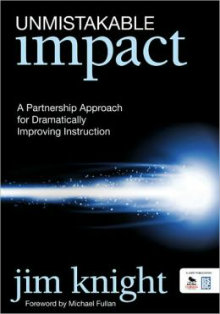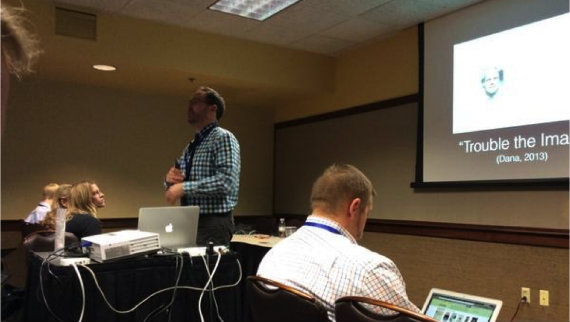Tools for Schools with Instructional Coaching
Unmistakable Impact: A Partnership Approach for Dramatically Improving Instruction
By Jim Knight
(Corwin/Learning Forward, 2011 – Learn more)

I met Jim Knight at the Wisconsin State Reading Association convention in 2013. He presented on instructional coaching strategies. After listening to him speak, I was impressed with his delivery, content, and responsiveness to people’s questions.
After a session, Jim also took the time to listen to me speak about our school’s instructional coaching experiences. He offered advice and appeared genuinely interested in what I had to share. I took away some great ideas from this experience.

Knight digs deeper into his motivation for writing this book: In the buildings he has visited, principals are often ill-prepared to meet the instructional leadership demands of today’s schools. Yet in spite of the obvious need for training and support, “principals often receive less professional development than anyone else in a district”(xiii). As an elementary principal, I can attest to this.
Knight’s outlook on partnership
Knight uses an informative and casual manner when introducing his framework for instruction. He highlights several examples throughout the text from the coaching residencies that he leads in the U.S.
In the first chapter, “Partnership,”Knight speaks to the importance of developing relationships and building trust between teachers and administrators before engaging in deep conversations about classroom instruction. Staff should have the chance to “discuss, dialogue, and then decide together”(29) about school issues important to everyone.
He also homes in on the concept of “praxis,” defined as “the act of applying new ideas to our own lives”(43). When people can connect their lives with their actions, plus have time to reflect, praxis can be realized.
Knight devotes a considerable amount of the book to the role of the principal in this partnership approach to school-wide success. Knight notes that what a principal expects is often communicated in both words and actions. “Leaders who genuinely win the respect of their staff are those who never miss an opportunity to demonstrate their respect for others”(51).
He offers specific strategies for school leaders, such as leading professional development, monitoring instruction in the classroom, and mapping out progress of teacher performance. The author also believes that principals cannot meet their potential as leaders and partners in learning without the support of central office.
But What If You Don’t…
A few paragraphs into Chapter 4, “Instructional Coaching,” I realized that this book was written through the lens of Jim Knight’s own experiences, working with schools that allocated funds toward instructional coach positions. In my school and in others I am connected with, instructional coaches do not exist. They are often the first positions cut when budgets become tight. This is not a judgment of the importance of their role. It is just the reality that too many schools face when having to make no-win decisions due to declining enrollment and poor state aid allocation formulas, such as in Wisconsin.
Although this chapter was not terribly relevant to my situation, I still found good information on how a principal can lead like a coach. For instance, Knight emphasizes the importance of providing choice with staff development, while still expecting all teachers to participate. “No professional can choose to be unprofessional”(93).
He also identifies some helpful questions for school leaders to ask their teachers after a coaching conversation, such as “How has what you have learned changed your thinking about instruction?” These are helpful tips to use with a coaching mindset.
Saving Grace
The next chapter, “Workshops That Make an Impact,” was worth any difficulties I had in the instructional coaching section. Knight offers some tried and true strategies for presenting professional learning activities. He continues the theme of taking a partnership approach when planning, such as asking for ideas and suggestions during leadership meetings. The author also provides specific steps a leader needs to take when preparing staff learning opportunities.
Two of my favorites include mapping out the presentation on paper before creating it on a computer, and using the 10-minute rule when speaking (don’t speak for more than 10 minutes straight without integrating a thinking or doing activity). In fact, I liked the ideas so much that I applied them at a technology conference where I presented. The feedback on Twitter told me that the strategies I applied from the book helped make my sessions a success.
Wrapping up the book
The final two chapters describe the role of intensive leadership teams and how to apply partnership communication in initiating school-wide change. Within the chapter on leadership teams, Knight provides guidelines on how to get started, protocols for structuring conversations, and directions for developing team values.
For partnership communication, the author guides the reader on how to apply essential listening skills, such as asking questions that are open-ended, genuinely curious, and nonjudgmental. The book wraps up with a robust appendix, referred to as an “Impact Toolkit.” It is filled with relevant ideas for any leader looking to improve a school’s collective instruction.
Conclusion
Despite the decision to aim the content of this book toward schools with instructional coaches, there are many reasons to purchase Knight’s text. It has a tight focus on a leadership concept (“partnership”), spends sizable time describing the principal’s role in improving instruction, and contains a wealth of information about coaching. If your building does not have an instructional coach, the chapter on workshops more than makes up for the book’s narrowed focus.
Unmistakable Impact concludes with two chapters on how a school can apply partnership principles to whole school initiatives. The resources in the appendix are easy to use and plentiful. Even if Unmistakable Impact may be less-than-perfect book for me, it just might be the perfect book for principals and instructional coaches who are developing the coaching model in their schools.
Matt Renwick is a 16-year public educator who began as a 5th and 6th grade teacher in a country school outside of Wisconsin Rapids, WI. After seven years of teaching, he served as a junior high dean of students, assistant principal and athletic director before becoming an elementary school leader in Wisconsin Rapids. Matt blogs at Reading by Example, tweets @ReadByExample and also writes for EdTech magazine and other publications. His book Digital Student Portfolios: A Whole School Approach to Connected Learning and Continuous Improvement was published in July 2014.
































